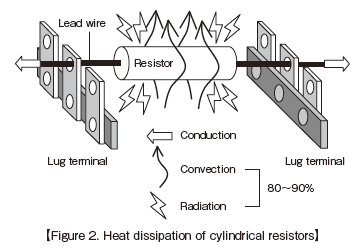Overview of the establishment of the derating curves based on ambient temperature
The idea of the traditional derating curve based on the ambient
temperature defined in the JIS and IEC standard was established in the
vacuum tube era, far back from the appearance of the surface mount
resistors. There were no printed boards in those days and the cylindrical
shaped resistors with lead wires were wired in the air to lug terminals
as shown in Figure 2.

The Joule heat that is generated in the resistor is dissipated in three
pathways regardless of the shape of the resistor. The first path is
conduction to the connected parts such as the terminal. The second path
is convection including the heat transfer to the atmosphere by natural
convection and airflow. The third path is radiation by infrared.
The larger the area connected to the resistor becomes, the larger the
heat conduction will be. And the larger the surface area of the resistor
becomes, larger the convection and radiation will be.
When the cylindrical shape resistor with lead wire is mounted on the lug
terminal, the lead wire which is the heat path by conduction is thin and
long so the heat resistance is large and the heat dissipation will be small.
In the contrast, the heat dissipation ratio of the convection and radiation
becomes large since the area will be large. It is determined in the
simulation that 80% to 90% of the heat of the cylindrical shape resistor
with lead wire is dissipated directly into the ambient air. The
temperature of the resistor can be calculated by adding the ambient
temperature and the temperature rise caused by the self-heating, so the
ambient temperature will be most sufficient for the usage environment
temperature standard of the resistors. This is why the derating curve
based on ambient temperature was provided to the customers as the
index of design.